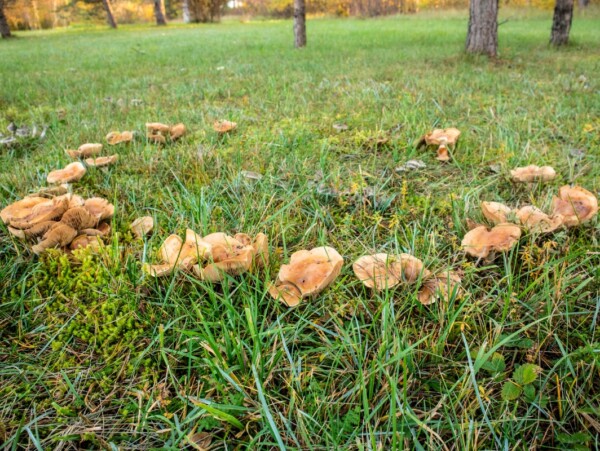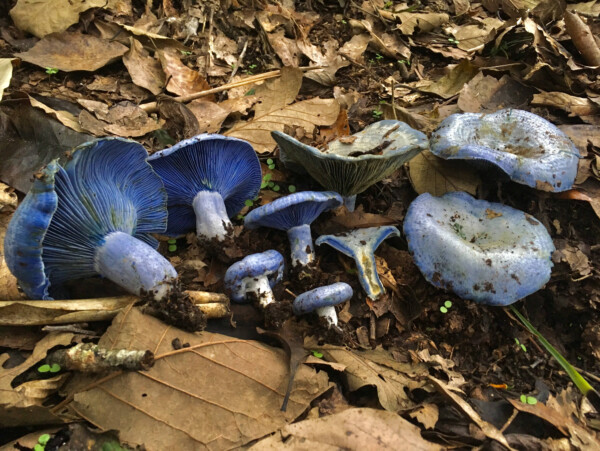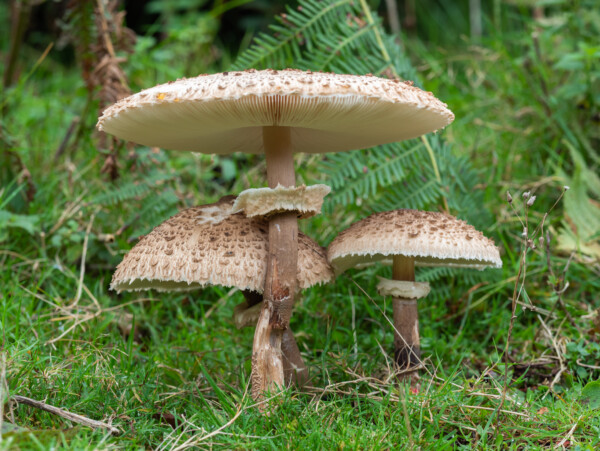Affiliate disclosure: This post may contain affiliate links. Please see our Privacy Policy.
Black Trumpet Mushrooms (Craterellus cornucopioides) are common, delicious edible mushrooms that are easy to identify. They’re perfect for beginning foragers because they have no close look alikes. Though common, they can be hard to spot because they blend in with the forest background.
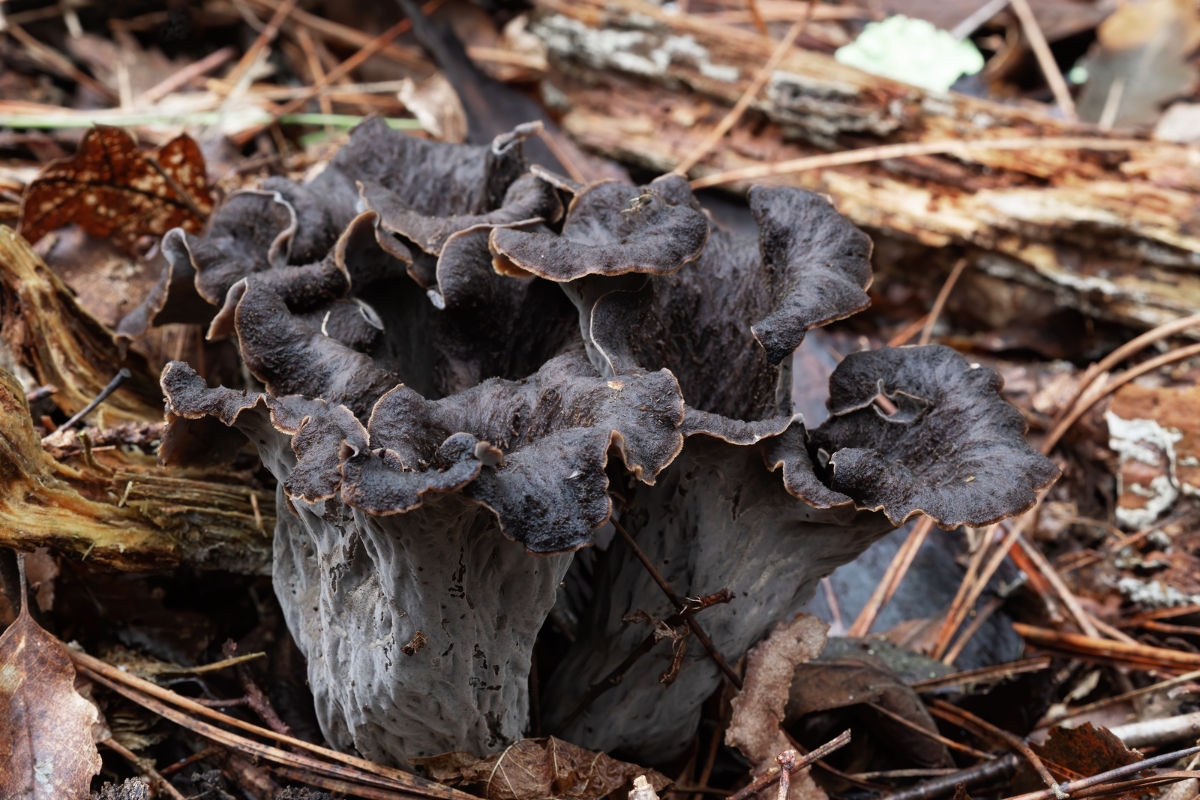
(This article was written by Timo Mendez, a freelance writer and amateur mycologist who has foraged wild mushrooms all over the world.)
When I first started mushroom hunting, I would spend every free moment looking for mushrooms. Even just a few hours in the afternoon was enough to hop on my bike and check some of my local spots. Living in the mushroom mecca of northern California, I didn’t have to go far to find something interesting.
That is, unless it was mid-winter and I wanted to find Black Trumpets.
These delicious morsels required a whole day mission, and usually a friend or two to make the long trip worthwhile. While I had heard of these being found locally, endless hours of scouting made those stories sound like pure forest legends. To find Black Trumpets, we would head two hours south to the steep and erosive geology of southern Humboldt County.
Here, we would delicately slip our way up a landslide to a spot known only to me and the closest of friends. Like many of our spots, this location was kept in secrecy by an unspoken oath. Thankfully, the sheer precarious geology of this spot kept it safe from most other pickers.
Every step up these steep, gravely hillsides was taken with mindful vigilance, almost as though we were walking on water. We would joke that this must be the reason why in France, they call them “Trumpets of Death.”
Eventually, we’d find our way up to old abandoned logging roads lined with mossy banks below a canopy of Douglas Fir and Tan Oak. If our timing was right and the season was promising, we would find bouquets of Black Trumpets erupting from the vibrant green moss along these old roads.
The time limit set by short winter days meant we would always arrive back in town past dark. Tired and often covered in mud, we would feast on a portion of them that night. The rest we would dry and split accordingly. Black trumpets dry quickly and only become more flavorful through this process. Their potent fruit-like aroma and truffle-like flavor have me salivating like Pavlov’s dogs just writing about it.
Eventually, we did discover Black Trumpets in the hills just east of town. The legends were true. We could have gotten hauls of similar proportions in about a quarter of the distance. Even still, these are experiences I don’t regret for a moment.
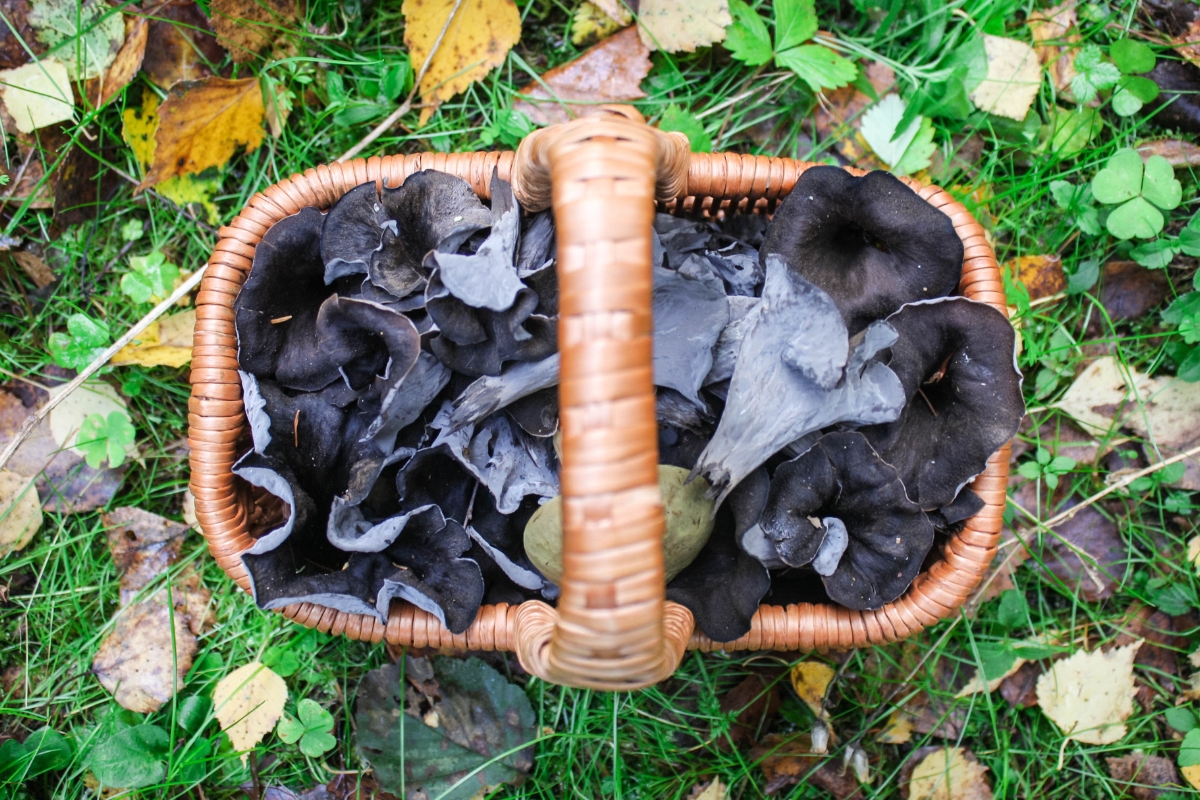
How To Find Black Trumpets
Black Trumpets are perfect mushrooms for beginner mushroom foragers.
They are easy to identify, have no close look-alikes, and are incredibly agreeable to the taste buds. Their wide distribution across the northern hemisphere also makes it likely that they are found in the woods near you. Also, don’t worry; they don’t only occur on dangerously steep slopes!
That said, Black Trumpets are some of the toughest mushrooms to actually spot in the woods. They do not have flashy colors like Chanterelles or Chicken of the Woods, which announce their presence. Instead, their dark color makes them easily camouflage into the surroundings like ghostly shadows.
From my experience, certain people are particularly talented at finding Black Trumpets. Other people (like myself) might not even see them if someone points at them directly! Thankfully, after finding a couple of patches, your mind’s “pattern recognition” abilities begin to kick in, and they become easier to spot.
Regardless, what’s more, important is not having a good pair of eyes. It knows exactly where and when to look.
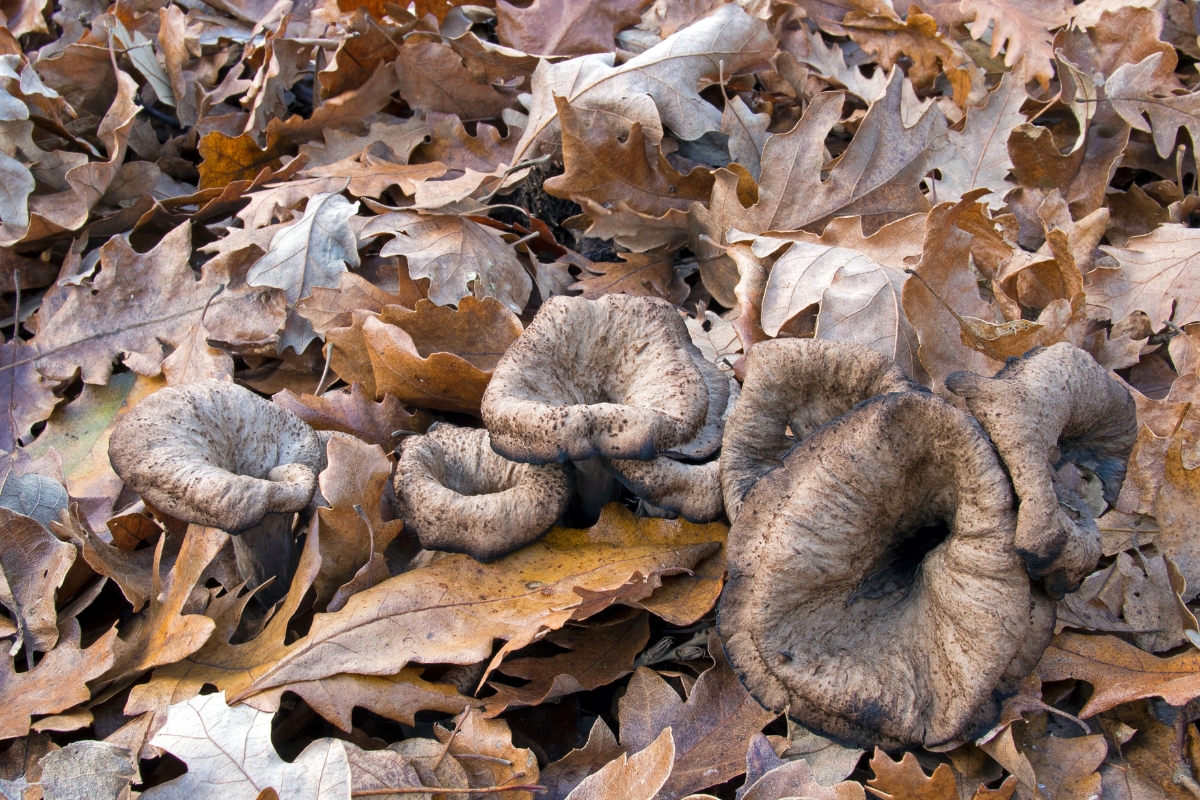
Where Do You Find Black Trumpets?
Black Trumpets occur throughout forested environments in the northern hemisphere. They are found in the United States, Canada, Mexico, Central America, Europe, and Asia. While they are widespread, they do not occur in all types of forests.
They grow directly from the soil beneath the canopy of specific trees, and they form symbiotic relationships with these particular trees. These include Oak, Beech, Madrone, and other broad leaved trees. In the eastern United States, they also associate with Hemlock. It is only through this symbiosis, known as a “mycorrhizal relationship,” that Black Trumpets can grow.
- Black Trumpets in The Eastern United States and Canada: Black Trumpets are widespread east of the great plains in Oak and Hemlock forests. They are found from northern Florida (Orlando-Tampa area) up along the eastern states to Maine and even Nova Scotia in Canada. They are found as far west as east Texas and Oklahoma up to the Great Lakes region. Appalachia and other mountainous regions are hot spots in the eastern US.
- Black Trumpets in the Western United States: Black Trumpets are found in California, Oregon, and Washington. Here they grow alongside Tan Oak, Coast Live Oak, and Madrone. In California, they grow as far south as Santa Cruz and occur mainly along the coast ranges. Further north, they are widespread in mixed forests with Tan Oak.
- Black Trumpets in Mexico and Central America: Black Trumpets are a bit more scarce here, but they can be found in the montane Oak forests as far south as Panama.
- Black Trumpets in Europe and Asia: Here, Black Trumpets can be found in Oak and Beech forests. They are most common in western/southern Europe, although they are seen as far north as Finland.
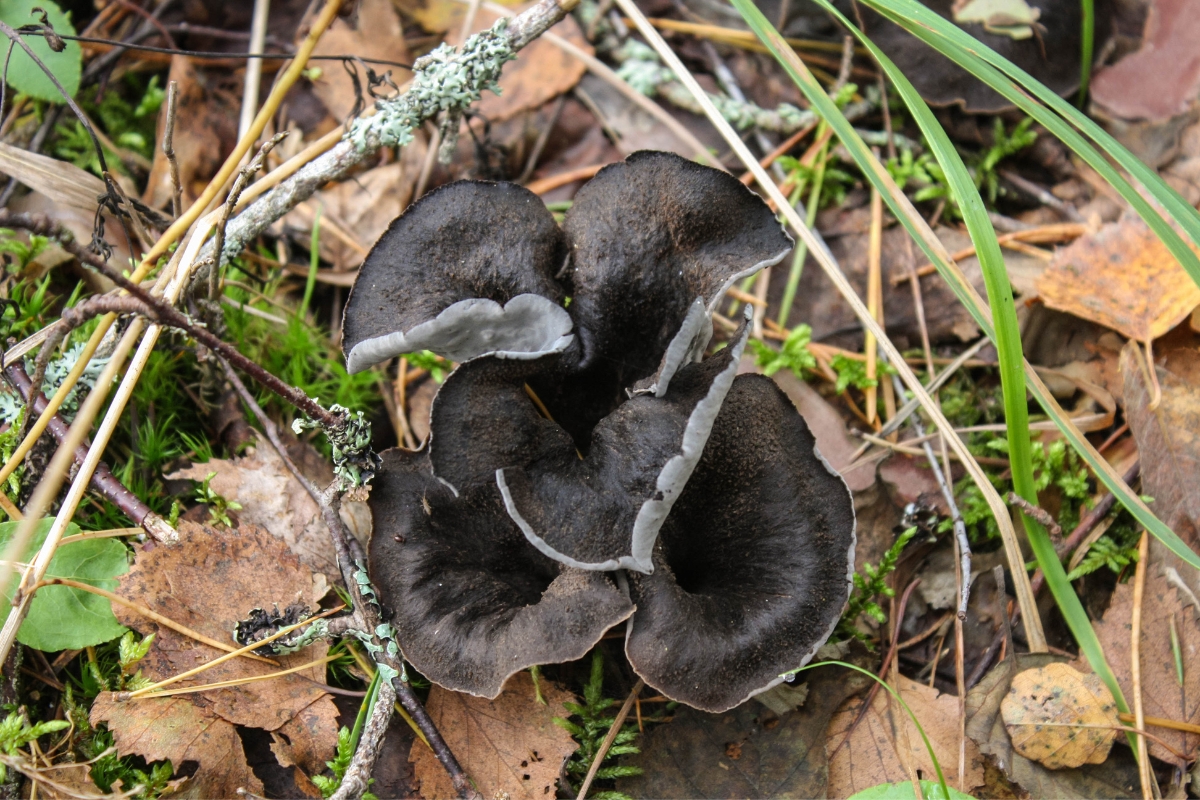
Tips for Finding Black Trumpets
Though easy to identify, black trumpets can be tricky to spot.
- Where there’s one, there are many. If you find some, thoroughly look in the area for more. More often than not, these fruit in patches that can be from 3-12 feet in diameter. If possible, consider the tree they associate with and scour the perimeter.
- Look for mossy, steep banks. While this is certainly not the only environment they grow in, it is common to spot them growing directly out of lush moss.
- It is not uncommon to see them along roadsides, old logging roads, and areas with a legacy of disturbance.
- Get low. Sometimes getting as close to the ground as possible gives you the best vantage point for spotting trumpets. This is particularly useful if you’ve already found some and want to spot more in the patch.
When To Forage Black Trumpets
Black trumpet mushrooms are found all over the world, but their season varies by geographic location.
In the Eastern United States, Canada, Mexico, and Central America, Black Trumpets are typically found during the summer. Their season ranges from June to September, with peak season occurring in August. It is not unheard of to see them as early as May and as late as November.
Out in the Western United States, Black Trumpets are considered more of a winter mushroom in the western states. Their season usually starts around November and goes until April. Peak season usually occurs in December-January.
Across the ocean in Europe, Black Trumpets occur in the fall, with peak season occurring around October. The further south you go, the later in the season. In Portugal and Spain, you may be able to harvest Black Trumpets as late as January or February during mild winters.
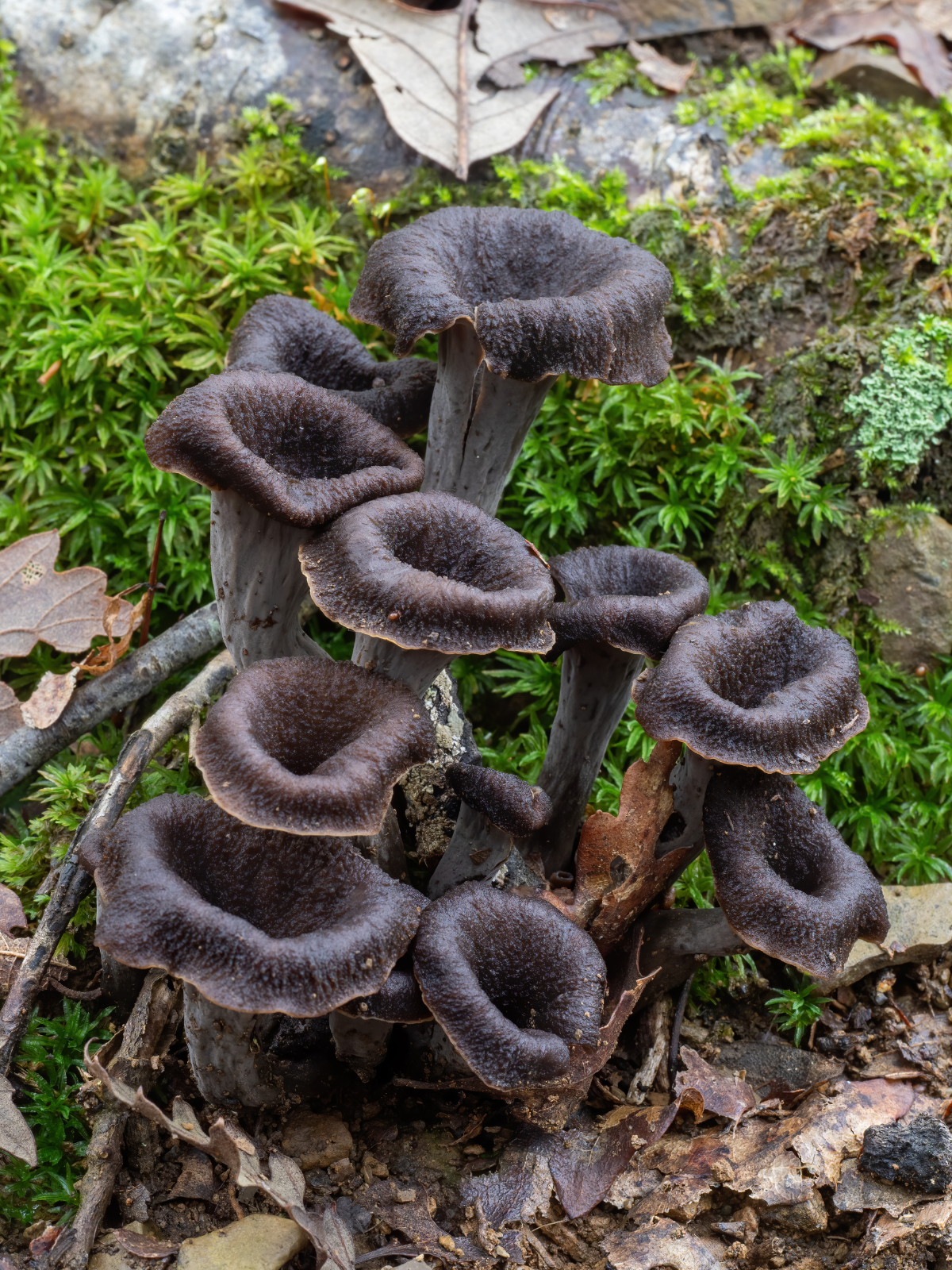
Black Trumpet Latin Name
Scientifically, there are at least three different species of Black Trumpets. This information is not necessary for your average forager because each species looks identical to the naked eye. Each of these species is unique to a particular geographic location.
- Craterellus cornucopioides only occurs in Europe and Asia. It has white spores. This was the first name given to Black Trumpets and is often what you will see in many mushroom-identification books.
- Craterellus fallax is found in the eastern United States, Canada, Mexico, and Central America. It is unique compared to the others because of its yellow-colored spores.
- Craterellus calicornucopioides occurs in California, Oregon, Washington, and western Canada. This species was described in 2015 and also has white spores.
Identifying Black Trumpets
Black Trumpets are easy to identify and well-described by their common name. They are about 3-4 inches in height, dark in color, and have thin paper-like flesh. The mushroom is essentially hollow and tube-like. They have no distinctive cap, stem, or gills. Their surface is, for the most part, completely smooth other than some thin scales that may form on the top of the mushroom.
The outside of the mushroom is gray in color, while the inside is dark-gray to Black. The top of the mushrooms are wider and funnel down to a thin tapered stem. The top of the mushroom often flattens or curls out, forming a pseudo-cap, often with a wavy margin.
The mushrooms most often grow in patches, and many times they occur in bouquet-like clusters, with multiple mushrooms growing from the same point. In less prolific patches, the mushrooms may grow individually. Black Trumpets have a fragrant fruit-like aroma. It is pretty rare, but occasionally you may find yellow or even albino Black Trumpets.
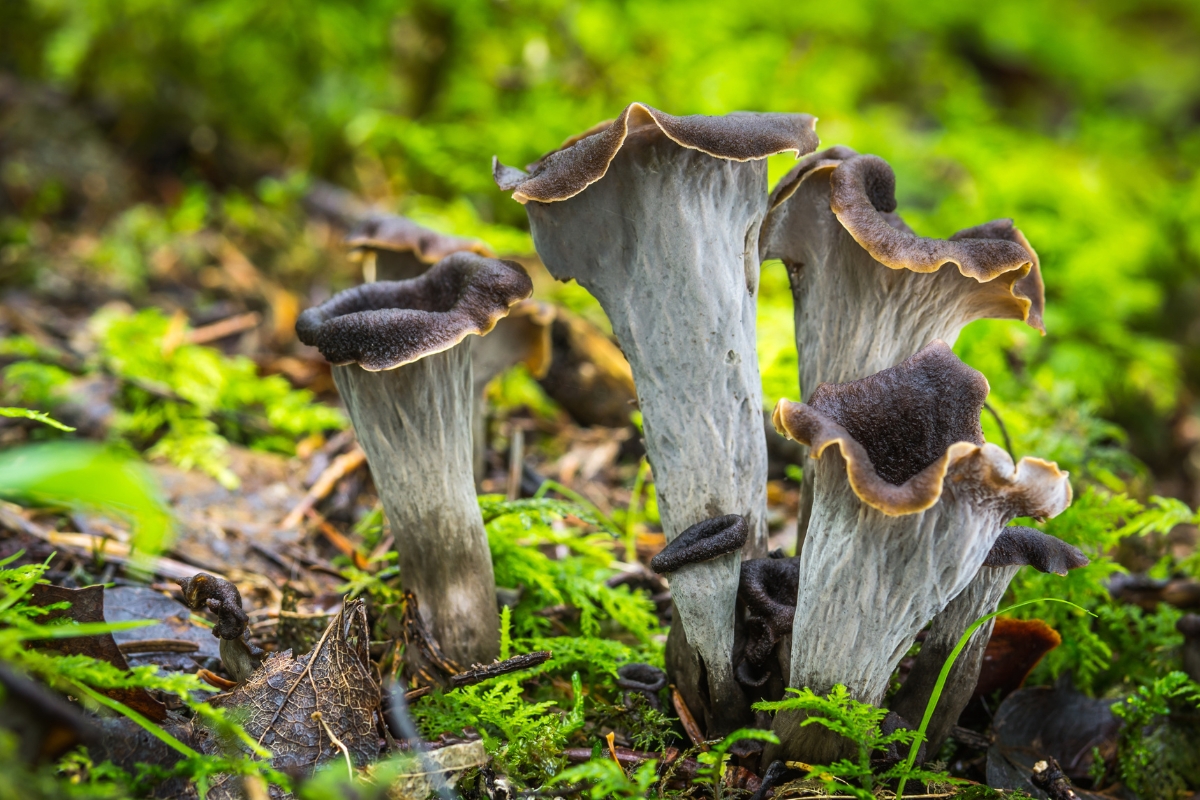
Key Identification Characteristics
The main things you need to identify black trumpet mushrooms include:
- Dark-colored tube-like mushroom, usually 2-4 inches in size.
- Light gray on the outside and black on the inside.
- It is usually funnel-shaped and often curls out towards the top, giving it its “trumpet-like” appearance.
- The flesh is thin, papery, and smooth.
- There are no distinctive gills, stem, or cap.
- There is a fragrant fruit-like aroma.
Black Trumpet Look-Alikes
Black Trumpets do not have any real look-alikes. It would be very difficult for most foragers to mistake Black Trumpets for some other mushroom. That said, always double-check with an expert if you experience any doubt.
The Top Black Trumpet Look-Alikes Include:
- Urnula craterium “Devil’s Urn” – This is a black cup-shaped mushroom that can be found growing on wood and other organic material. It can easily be differentiated by its more spherical shape, brown spores, and scaly outer surface. The flesh is much more fragile than a Black Trumpet.
- Helvella lacunosa “Elfin Saddle” – This mushroom has a similar color scheme as black trumpets, but it has a large and irregular-shaped cap. The stems also have vein-like ridges that run down their surface. When these mushrooms are old, their caps may rot, leaving only the stems, which could be mistaken for Black Trumpets.
- Craterellus cinereus “Ashen Chanterelle” – This is a black trumpet relative that has wrinkle-like gills. It is very rare, and thankfully if you find it, it is also a choice edible! Depending on where you are in the world, there are other gilled Black Trumpet relatives.
Harvesting Black Trumpet Mushrooms
Like any foraged food, harvest Black Trumpets with respect. Only harvest once the mushrooms are adequate in size (2-4 inches) and leave some behind for wildlife, foragers, and so the mushrooms can complete their life cycle. Avoid harvesting mushrooms that are old, moldy, slimy, bug-ridden, or too old to eat. Eating old mushrooms like this can cause food poisoning.
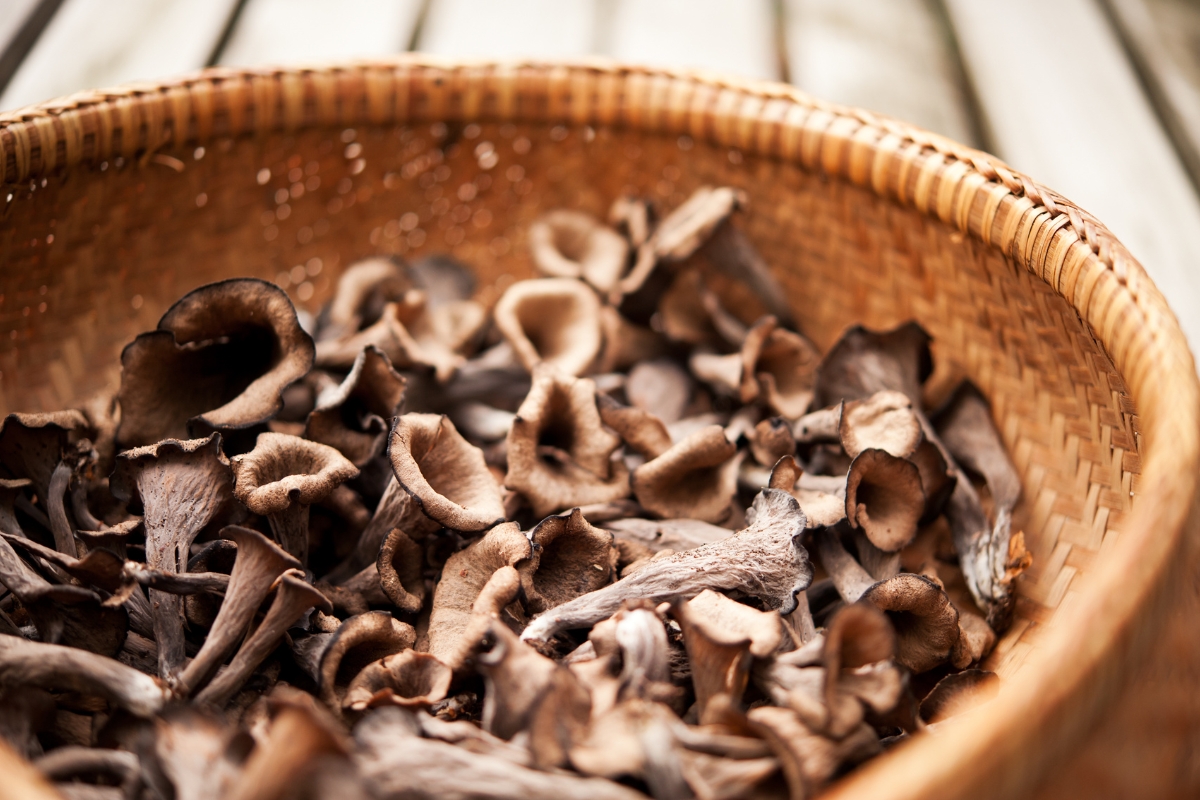
Picking or Cutting?
Many foragers believe it is best to harvest mushrooms by cutting the stems. Others believe it is better to pluck the mushroom directly as this will reduce the possibility of spreading an infection to the mycelium. Scientific studies on the subject have shown very little difference one way or the other.
Regardless, the base of Black Trumpet mushrooms are often covered in dirt and should be cut off anyways. Placing mushrooms with dirty stem butts into your bag or basket will get dirt over all the mushrooms and make them more laborious to clean later. Whether you want to cut the stem butts directly or after plucking, I’ll leave it up to you.
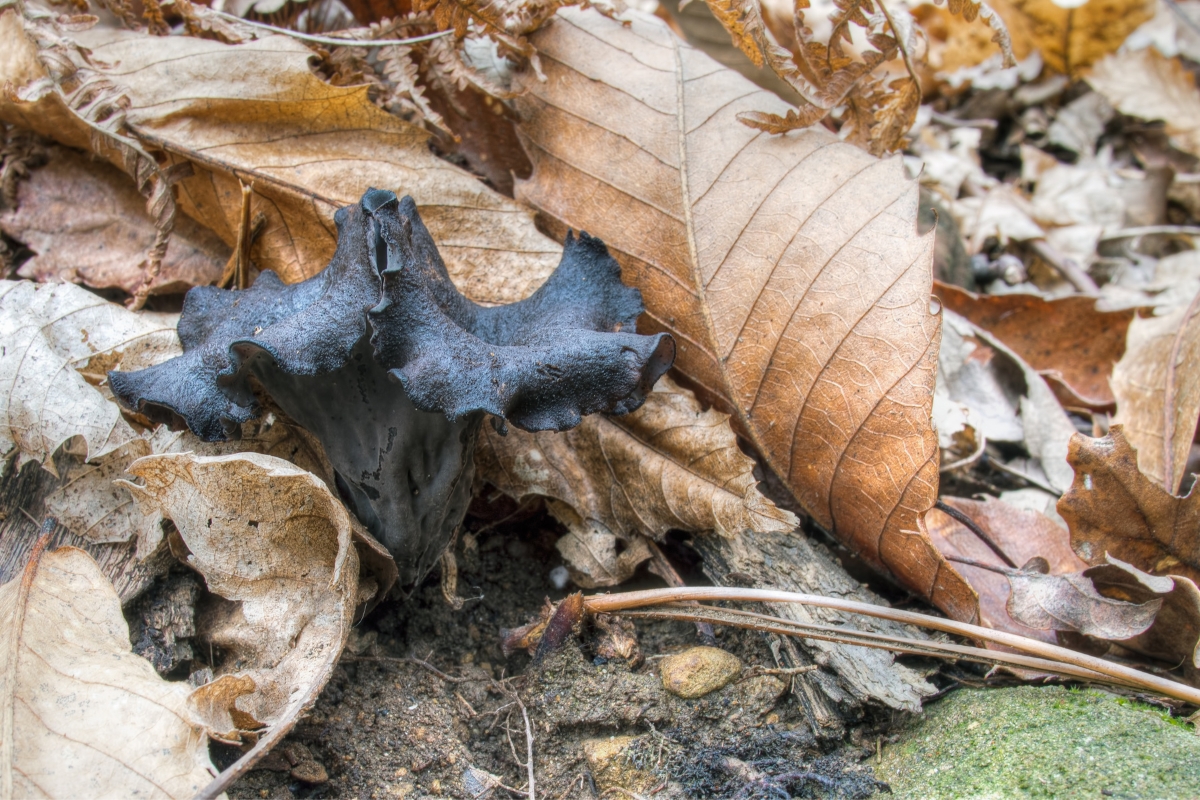
Cooking and Using Black Trumpet Mushrooms
Black Trumpets are a favorite culinary mushroom amongst foragers and mushroom enthusiasts.
For some folks, it is one of the few mushrooms in the short list of species they enjoy. They do not have the slimy texture disliked by some, and their flavor pleases even the pickiest of eaters. For this reason, it makes it perfect for those unfamiliar with mushrooms’ unique culinary attributes.
Black Trumpet mushrooms are an excellent addition to almost any savory dish. Whether you want them in omelets, pasta, risotto, or alongside a steak, they’ll do wonders to enhance the flavor.
You can also cook them with garlic, onion, and parsley for a simple garnish. Black Trumpets are a great addition to cream-based sauces of any type. Make sure to cook them thoroughly to avoid indigestion. In Europe, they are also commonly consumed dried and powdered, which can be added during the cooking phase of any meal.

Preserving Black Trumpet Mushrooms
When it comes to preserving Black Trumpets, dehydration the best method. The drying process acutally enhances the fragrant aroma and flavor of Black Trumpets. This produces the “truffle-like” flavors that are so highly valued in this mushroom. Plus, the thin, papery skin of Black Trumpets makes them particularly well-suited to drying.
How To Dry Black Trumpets
Drying black trumpet mushrooms is easy.
You can simply place Black Trumpets in the sun on a piece of cardboard. If it is a sunny day, they should dry within 12 hours.
Alternatively, speed up the drying by blowing air on them with a fan. Make sure it is at a safe distance so it won’t blow away the mushrooms once they are dry!
You can also place them near a wood-burning stove or heater, or pop them in a conventional dehydrator.
The last option is oven dehydrating. Place them on a baking tray in the oven at the lowest temperature setting. Leave the door slightly ajar using a spoon or some other object to prevent it from closing.
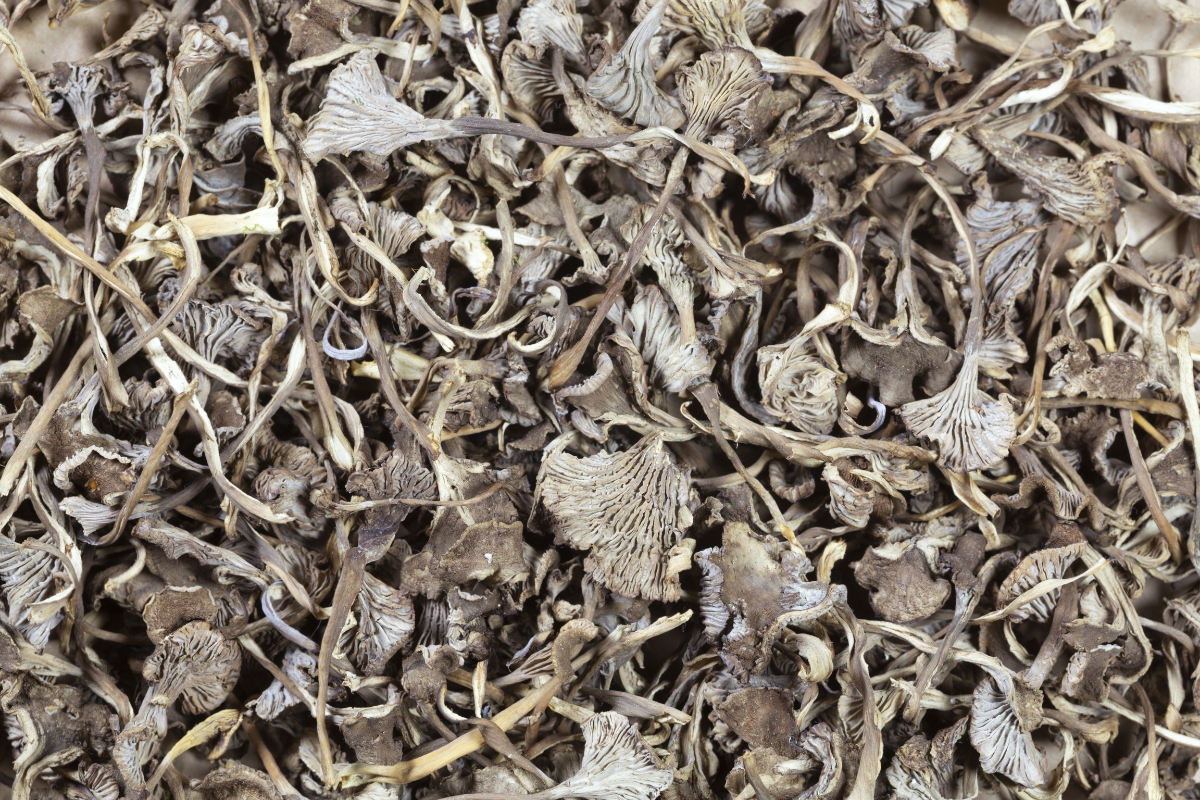
Other Ways To Preserve Black Trumpets
If you don’t have adequate conditions for dehydration, you can also cook the mushrooms and place them in a freezer. Do not freeze raw mushrooms, as their texture will become “gooey” and not so pleasurable. If you want to experiment, you could parboil the mushrooms and pickle them via your preferred method.
Honestly, though, they are so good and easy to dehydrate that this is always my favorite way to preserve them!
Mushroom Foraging Guides
Looking for more mushroom identification guides?
- Morel Mushrooms
- Chaga Mushrooms
- Witches Butter Mushrooms
- Puffball Mushrooms
- Shaggy Mane Mushrooms
- Reishi Mushrooms
- Turkey Tail Mushrooms
- Dryad’s Saddle
Foraging Guides
Mushrooms aren’t the only thing you can find in the woods. Keep your eyes open for these edible wild plants to fill your basket:
- Foraging Wild Black Cherry (Prunus serotina)
- Foraging Black Walnuts (Juglans nigra)
- Foraging Fireweed (Rosebay Willowherb)
- Foraging Marsh Marigold (Caltha palustris)
- Foraging Partridgeberry (Mitchella repens)
- Foraging Fiddlehead Ferns
- Foraging Ramps (Wild Leeks)
- Foraging Wild Asparagus


